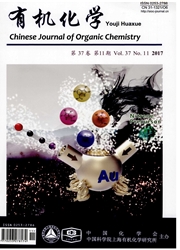

 中文摘要:
中文摘要:
研究了不同的Lewis酸催化剂、温度、微波等条件下,4-(4.甲氧苯基)-1-苯基-3-三甲基硅氧基-2-氮杂-1,3-丁二烯(2-ABDE)和亲二烯体环己酮发生杂Diels-Alder反应生成[4+2]的六元环合产物嗯嗪酮衍生物,伴随的2-ABDE的[2+2]单分子环合,生成单环β-内酰胺衍生物.结果表明:在低温条件下如(-78℃)[4+2]反应占主导;而在高温条件下(如135℃)仅进行[2+2]反应.微波加热方式可显著提高[2+2]反应的速率和产率.不同的Lewis酸催化剂对[2+2]反应和[4+2]反应的催化效率不同.Lewis酸的酸性强弱、软硬对2-ABDE的[2+2]反应的催化能力起决定性作用.
 英文摘要:
英文摘要:
During the hetero Diels-Alder reaction (HAD) between 4-(4-methoxyphenyl)-1-phenyl-3- (trimethylsilyloxy)-2-aza-butadiene (2-ABDE) and hexanone, a unimolecular [2+2] cyclization of 2-ABDE forming a four-membered monocyclic β-lactam took place. The reaction parameters such as Lewis acid catalysts, temperature and microwave irradiation on the HDA and [2+2] reactions have been thoroughly studied. The results show that the competition between the [2 +2] and [4 +2] reactions is largely dependent of temperature. At low temperature as -78 ℃, the product of [4+2] reaction predominated, while at high temperature as 135 ℃, the product of [2+2] reaction predominated. Microwave irradiation improved the yield of the [2+2] reaction significantly. It was also found that the strength and the hardness of the Lewis acid affected the catalytic ability for the [2 + 2] reaction of 2-azabutadiene.
 同期刊论文项目
同期刊论文项目
 同项目期刊论文
同项目期刊论文
 Prediction of Cell-Penetrating Peptides Using both Support Vector Machine and Linear Discriminant An
Prediction of Cell-Penetrating Peptides Using both Support Vector Machine and Linear Discriminant An Establishment and application of a new method for the determination of kinetic parameters by plug-pl
Establishment and application of a new method for the determination of kinetic parameters by plug-pl Improvement of microemulsion electrokinetic chromatography for measuring octanol-water partition coe
Improvement of microemulsion electrokinetic chromatography for measuring octanol-water partition coe 期刊信息
期刊信息
